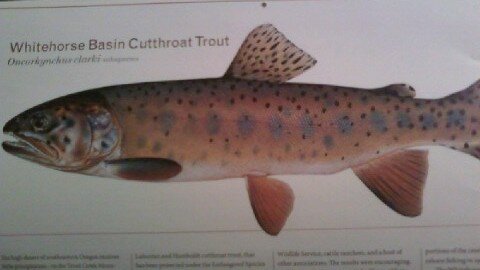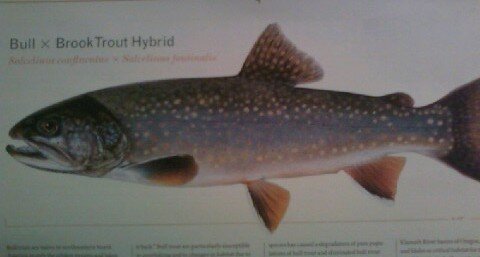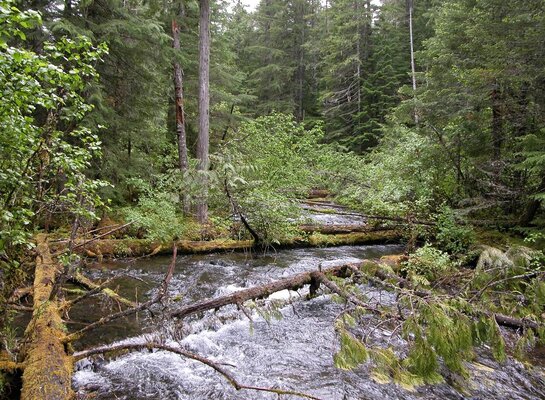L
lilsalmon
Well-known member
So, I bought this awesome calendar at the Expo that has some very interesting info in it....I am going to try and share some of it with whoever wants to read this. I know your idea of a calendar wouldn't be trout....hehe.....but this is my pinup of choice right now.  Excuse the pic, it was taken on my cell...
Excuse the pic, it was taken on my cell...
Whitehorse Basin Cutthroat Trout
Oncorhynchus clarki subspecies
The high desert of southeastern Oregon receives little precipitation--in the Trout Creek Mountains, only about 8 to 10 inches fall each year. Half of this water arrives as snow during the winter months and feeds Willow and Whitehorse creeks in the spring. These creeks serve as oases for a variety of vegetation and wildlife throughout the year. One inhabitant found swimming in these waters is the Whitehorse Basin cutthroat trout, a unique form of cutthroat related to the Lahontan and Humboldt cutthroat trout that has been protected under the Endangered Species Act since 1973. However, despite its protection under the Act, the U.S. Bureau of Land Management permitted open cattle grazing throughout the Whitehorse Basin, which caused progressive stream degradation and steady declines in fish populations. In the early 1990s, the Bureau altered its policy by cooperating with environmental groups, angling organizations, the U.S. Fish and Wildlife Service, cattle ranchers, and a host of other associations. The results were encouraging, and the riparian areas sprouted willows, alders, wild roses, and other vegetation, which shade the streams in summer and prevent bank erosion. Insects attracted to the vegetation and to ample moisture returned in fair numbers, too. This meant good things for the trout--cooler, deeper water and a steady supply of food brought the fish back, and their numbers increased appreciably. Indeed, portions of the creek were opened to catch-and-release fishing in 1999.
The Whitehorse Basin cutthroat trout is greenish bronze along the back and softly pink and yellow on its flanks. It has round spots evenly scattered above the midline of the fish and even has spots on its head, an unusual trait for inland cutthroat. These fish average between 6 and 14 inches in length, depending on availability of food and suitable habitat.
Whitehorse Basin Cutthroat Trout
Oncorhynchus clarki subspecies
The high desert of southeastern Oregon receives little precipitation--in the Trout Creek Mountains, only about 8 to 10 inches fall each year. Half of this water arrives as snow during the winter months and feeds Willow and Whitehorse creeks in the spring. These creeks serve as oases for a variety of vegetation and wildlife throughout the year. One inhabitant found swimming in these waters is the Whitehorse Basin cutthroat trout, a unique form of cutthroat related to the Lahontan and Humboldt cutthroat trout that has been protected under the Endangered Species Act since 1973. However, despite its protection under the Act, the U.S. Bureau of Land Management permitted open cattle grazing throughout the Whitehorse Basin, which caused progressive stream degradation and steady declines in fish populations. In the early 1990s, the Bureau altered its policy by cooperating with environmental groups, angling organizations, the U.S. Fish and Wildlife Service, cattle ranchers, and a host of other associations. The results were encouraging, and the riparian areas sprouted willows, alders, wild roses, and other vegetation, which shade the streams in summer and prevent bank erosion. Insects attracted to the vegetation and to ample moisture returned in fair numbers, too. This meant good things for the trout--cooler, deeper water and a steady supply of food brought the fish back, and their numbers increased appreciably. Indeed, portions of the creek were opened to catch-and-release fishing in 1999.
The Whitehorse Basin cutthroat trout is greenish bronze along the back and softly pink and yellow on its flanks. It has round spots evenly scattered above the midline of the fish and even has spots on its head, an unusual trait for inland cutthroat. These fish average between 6 and 14 inches in length, depending on availability of food and suitable habitat.


